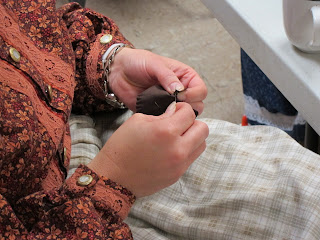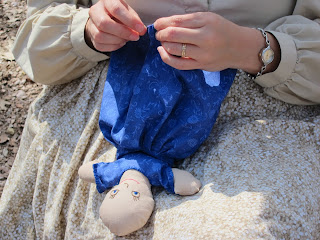
As educator and collections manager (and volunteer coordinator, marketer, cat wrangler, and harbinger of useless knowledge, amongst other things), many interesting questions come across my desk daily. Our visitors have fascinating insights and delightfully insatiable curiosity which we take it upon ourselves to feed on a regular basis. After all, isn't this what truly makes history come alive?
Unfortunately for me, there are more questions than I can ever possibly answer in one day. So as time allows, I research items and share the results with our historical interpreters so that they might share them with you. Sometimes scholarship changes in light of new evidence...and sometimes "rumors" comingle with the truth. After a while it can be tricky to separate legend from fact!
The Village People do their best, however, to provide you with most complete, accurate, and up-to-date historical info so that you can learn and share this info with family, friends, coworkers, and anyone else who will listen.
Some of our most difficult questions stem from word and phrase etymology (i.e. what is the origin of this word/phrase). A number of factors make etymology difficult to determine. For one thing, we're typically working with a modern English equivalent which may be comprised of several different root languages, causing the word or phrase to literally evolve over time. Another complication comes from the human desire to "make things make sense" regardless of what actually happened (i.e. "well...this thing pops and it's called a weasel...so that must be where 'Pop Goes the Weasel' comes from"--which is an unsubstantiated story, by the way).
As a trusted source of information, we constantly work to separate fact from fiction and myth from reality. And sometimes we have to truly admit that we just don't know.
Recently a visitor asked about the origin of the word "heirloom." Did it literally start off as meaning a loom that was passed down through generations? Short answer? Maybe.
The results I found were somewhat conflicted...but all agreed that "loom" came from the Old English word "lome" which translates to "tool or implement." After that, there's some disagreement. You can read for yourself from the excerpts I've included (verbatim) below:
heirloom late 15c., ayre lome, from heir + loom in its original but now otherwise obsolete sense of "implement, tool." Technically, some piece of property that by will or custom passes down with the real estate. http://www.etymonline.com/index.php?term=heirloom "The "heir" in "heirloom" is our familiar English word, meaning, as the Oxford English Dictionary puts it, "The person who is entitled by law to succeed another in the enjoyment of property or rank, upon the death of the latter; one who so succeeds; in general use, one who receives or is entitled to receive property of any kind as the legal representative of a former owner." The word "heir" comes to us, via Old French, from the Latin "heres," which simply meant "heir." Today we also use "heir" in a looser sense of "inheritor" or "successor."
The "loom" part of "heirloom" does indeed come from the Middle English "lome," originally meaning any sort of tool or implement. The use of "loom" to mean specifically a weaving machine dates to the early 15th century. "Heirloom," which also appeared in the 1400s, harks back to the broader meaning of "loom" and originally simply meant any property (tools, etc.) that could be inherited the way real estate is. The modern sense of something that has been handed down for generations appeared only in the 17th century. http://www.word-detective.com/101404.html
"Heirloom" is a compound word, the kind of word that is frequently "coined" in our language, because we have a tendency to link two nouns, first using one as an adjective to describe the other, and then actually joining the two words to make one word. The usual pattern in the English language is to use the two words separately and then, over a period of years [which could be 10 or 100] we combine them. For instance, a court house was originally the combination of two nouns -- a court, where legal cases were heard, and a house, which is a building. Over a period of time, we joined the words together using a hyphen: court-house. Then, as we are accustomed to do, we got rid of the hyphen, so that our current word is "courthouse." That is a combined word: from an noun [used as an adjective] with another noun, to a hyphenated expression, to one single word. The same case applies to heir and loom.
"Heir" arrived in the English language via the Middle English, who got it from the Old French, who took it from the Latin word "heres," which is related to the Greek word "cheros." The Latin "heres" actually means "heir." We also get such words as "heredity" from the same Latin root. "Heir" became part of the English language sometime in the 13th century. No one knows the actual date.
"Loom" comes from the Middle English "lome," which was a tool used for weaving, as well as being a generic word for any other type of tool, such as a farming implement. It is related to the Middle Dutch word "allame," which also is a weaving tool. But, as the working of the loom for weaving was a gradual process and the cloth appeared slowly, the finished product was said "to loom." From the sense, we get "loom" as a verb, meaning "to take shape as an impending occurrence."
"Heirloom" is a combination of those two ideas -- it cannot be a "gift" from a father or mother or some other elder in the family, because that would negate the "impending occurrence" aspect. An heirloom is "passed on" to the next generation, but in its original meaning, it was part of an estate -- not an outright gift from one person to another. Thus, it is an "impending" item that is passed from one generation to another, because of "heres" or "heredity."
Various dictionaries [including "Webster's Third Unabridged International"] provide the "impending" part of the meaning, but "The American Heritage Dictionary of the Engish Language" does not mention it. They believe that the original "heirlooms" were not items like jewelry or fine china, but were actually looms [for weaving] and other TOOLS, which I suppose would be valuable.
From "The American Heritage Dictionary of the English Language" -- NOUN: 1. A valued possession passed down in a family through succeeding generations. 2. An article of personal property included in an inherited estate. ETYMOLOGY: Middle English heirlome : heir, heir; + lome, implement; see loom2 http://en.allexperts.com/q/Etymology-Meaning-Words-1474/heirloom.htm
heirloom 1472, ayre lome, from heir (q.v.) + loom in its original but now otherwise obsolete sense of "implement, tool." Technically, some piece of property that by will or custom passes down with the real estate. http://dictionary.reference.com/etymology/heirloom
So who's right? Are pieces of all of them right? I can't say for certain, but at least I can tell you with confidence that a loom is a tool or implement, and the modern connation means a tool or implement that weaves cloth.
What are your thoughts? Have you done research on the topic?







